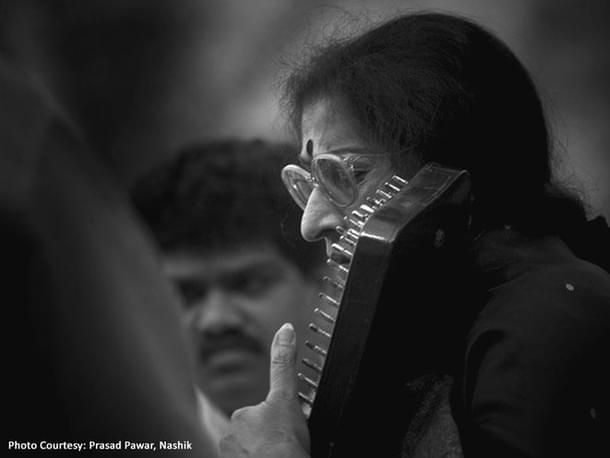Culture
Kishori Amonkar And Our Urge For Expression
Arush Tandon
Apr 28, 2017, 03:18 PM | Updated 03:18 PM IST
Save & read from anywhere!
Bookmark stories for easy access on any device or the Swarajya app.


She began with a Bahaduri Todi. This was in February, last year. In the first fifteen to twenty minutes it seemed like she was yet to enter the space of the raga, as if she was cajoling the melody to descend. By the 45-minute mark, there was a marked change in the environment of the Mahalaxmi Lawns in Karve Nagar of Pune. By the hour mark, if you had asked me whether Bahaduri Todi was present in the lawns, I would have said, “yes”. And I still stand by it, because while I feel utterly inept at describing the presence of a raga, I cannot disregard my experience of it.
Today, when Tai is no more and I’m writing this, I feel ill-equipped to do so, but not dishonest or imprudent. While I may not have knowledge about the grammar of Hindustani music, I can identify easily with ragas and the bhaavas therein. I may not be able to tell between a shuddh and a komal nishad at the first strum, but I can tell between a Bageshri and Bageshri Kanada, or a Megh and Vrindavani Sarang within the first few seconds. More importantly (for me), I can easily relate to the emotions inherent in Kishori tai’s music and that is why writing this now feels more like a natural reaction to the shock of events of 3 April than a task to be executed according to a template.
There’s a theory in ethnomusicology according to which language developed out of music. In a slight variant of this, both music and language developed from a common ‘proto-faculty’ that was primarily musical in nature. Read this, with the fact that out of all the forms of stimuli, it is sound which has the most powerful impact on the brain. The urge in humans to express, hence, is primordial, and is realised best through sound. And between music and language, music appears to be the more organic medium for humans to fulfill this desire of expression.
In all the forms this urge has been realised in, it’d be an arduous task to find a more evocative one than Kishori Amonkar’s music.
You may not know everything about the teevra madhyam in Yaman but that wouldn’t prevent you from immersing yourself completely in the serenity of her rendition of it. You may not know its intricacies, but that wouldn’t stop you from partaking in the meditative gaambhirya of her Bahaduri Todi. You may have no idea of the aaroh and avroh of Bageshri but the pine in her recital of it would strike deep, regardless.
Music cannot be for the sake of notes. Notes have to be for the sake of expression. To the immense fortune of thousands of her fans, this was Kishori Amonkar’s goal each time she ascended the stage. A great artist would be content with touching the right shrutis, the micronotes, one after the other, all neatly tied up in the beat cycles. But tai was greater still. For her that was only the first step towards her goal, the bare minimum required. The final goal was leading the audience to experience the same abstract bhaava of the raga which she herself was feeling. Her meditations on her art elevated her to the abstract state once she closed her eyes; her utter mastery of the craft enabled her to present that abstract in the form of swaras to the audience.
How did this focus on bhaava and projecting the abstract come to be? While that is a question whose final answer is best left to accomplished minds, a few things can be said based on her own admissions.
Tai’s bhakti and spirituality were at the core of her music. She has described her practice of it as sadhana, as opposed to looking at it as a performing art. Indeed, it is not difficult to imagine that each time she went on stage she was in fact worshipping her ishta while allowing the audience to watch and listen in on it.
On more than one occasion too, she had stressed on how important bhakti was to Hindustani music. In this sense, not only did her music represent the pinnacle of Hindustani tradition but she too was a perfect example of an artist staying true to the roots of Indic tradition and culture. Unlike most contemporary artists, Kishori tai did not differentiate between her spirituality and her chosen field of karma. Towards her discipline, she had literal religious devotion.
Her journey amongst mortals has ended, but our urge to express remains, and will always. And it is this urge, that will make us go back to her music, time and again. For in Kishori Amonkar’s swaras, this primordial instinct of man was realised perhaps in its most exalted and sacred form.
Arush Tandon is interested in icons of history, history of independent India and, Indian culture.





